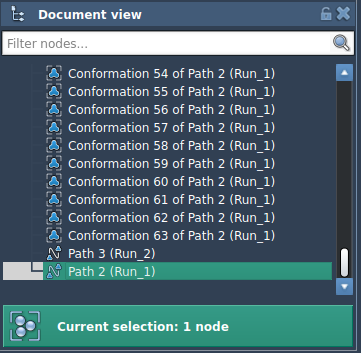When modeling molecular systems, predicting how a molecule transitions from one conformation to another—especially through complex pathways like ligand unbinding—is a frequent challenge. While generating an initial path using interpolation or sampling is a good start, these paths are rarely optimized and may not reflect a true minimum energy trajectory.
This is where the Parallel Nudged Elastic Band (P-NEB) method in SAMSON can be a useful tool. The P-NEB app helps you refine molecular transition paths by minimizing energies along the trajectory while balancing consistency in image distribution. It can be applied directly to a trajectory (called a path in SAMSON) or to a sequence of individual conformations.
Key Insight: If you already have a path (i.e., a trajectory node in SAMSON), you should prefer applying P-NEB to the path rather than to the individual conformations.
Why? Applying P-NEB directly to conformations actually performs the same computations, but takes longer and involves extra steps. It is more efficient to first convert conformations into a path (if necessary), and then apply the P-NEB app to the path.

In SAMSON, you can easily create a path from conformations:
- Select the conformations in the Document view
- Right-click and choose Conformation > Create path from conformations
After that, simply launch the P-NEB app from Home > Apps > All > P-NEB, select your path, and click Run.
You’ll be prompted to choose whether to use existing bonds when setting up the Universal Force Field (UFF). Select “use existing bonds” and confirm. The optimization process will begin and you can monitor the progress in the status bar.

Once completed, SAMSON will display the optimized path with the specified suffix. You can double-click it to view the improved molecular transition animation.

This simple workflow tip—starting with a path rather than a set of conformations—can save valuable time and compute resources, especially if you are analyzing large biomolecular systems.
To learn more about using the P-NEB app in SAMSON, visit the full documentation page here: Optimize transition paths with the Parallel Nudged Elastic Band method.
SAMSON and all SAMSON Extensions are free for non-commercial use. You can get SAMSON at https://www.samson-connect.net.





